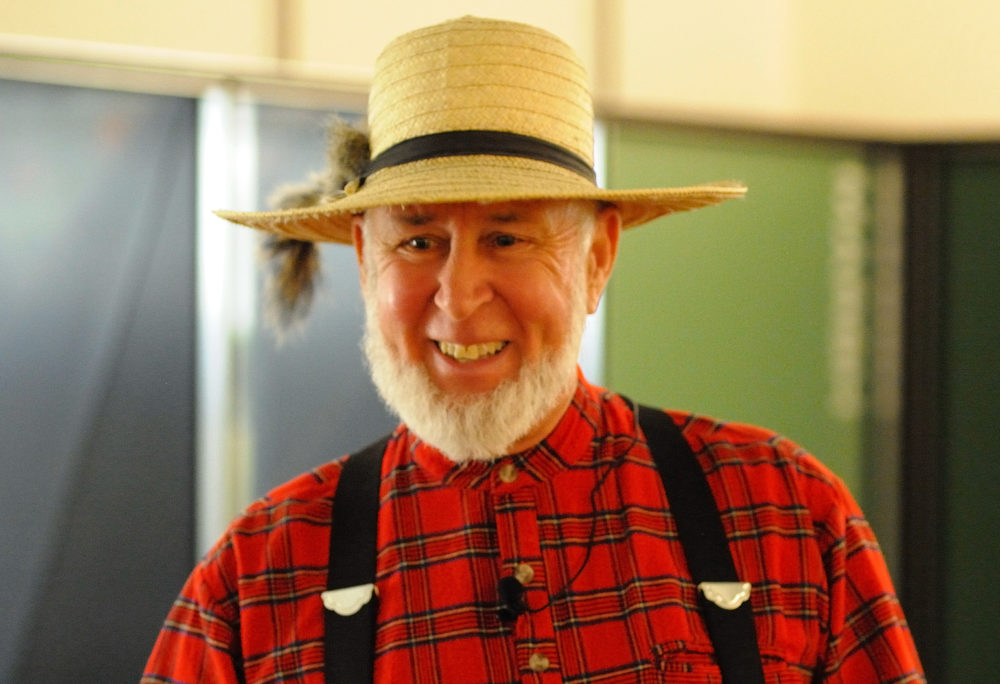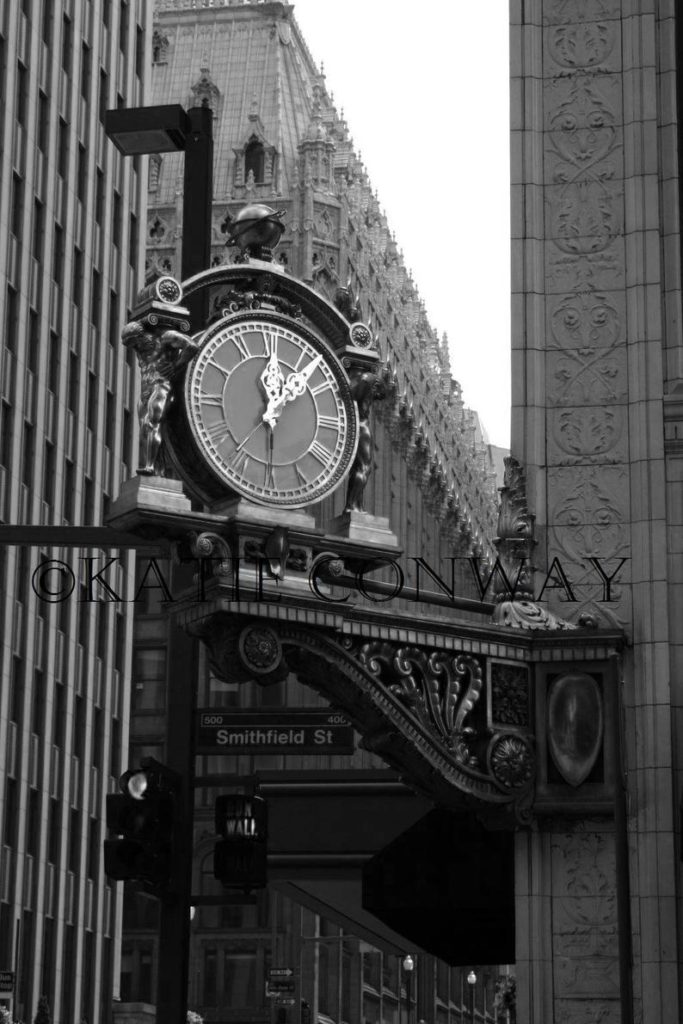
Going shopping today more than likely means going to “the Mall,” or at least to the “strip mall” those conglomerations of retail establishments that long ago took over from the center-of-town shopping districts of cities large and small. Oh yes, there are still places to shop in the center-city parts of town, but look closely and you’ll see that most are restaurants, mid-priced to trendy-chic, or antique stores and something called a “boutique.” There may be a corner beer joint here and there, but not many. The butcher, the baker, and the candle-stick maker, not to mention the dairy-store, the druggist, the shoemaker, and the “five and ten” are definitely not in town anymore. You have to go out the highway to find their successor – Wal-Mart!
But back in the day, a large part of the nation’s shopping was done “down town” ( or “dahn tahn” in proper Pittsburghese ) at one or more of the big department stores. My earliest Pittsburgh years were spent on the “Nor-side” of town, across the Allegheny from downtown. This area had been the entirely separate city of Allegheny, until it merged with Pittsburgh in the early 1900s. Yes that was before my time. We lived on Federal Street – way up Federal Street on what was known as the “extension.” So going to town meant going to the lower end of Federal Street to the big department store there – Boggs and Buhl. The Buhl family fortune built if not endowed the wonderful Planetarium on West Ohio Street, but that’s a different story. If the Boggs family had philanthropic tendencies, I never heard about it, as I don’t recall hearing the Boggs name anywhere else. The Boggs and Buhl department store stood along Federal Street right across from the Market house and sort of catty-corner from the Carnegie Library (among the first of the hundreds that Andrew Carnegie’s fortune funded by the way.) It wasn’t exactly catty-corner. There was a small parklet on the corner with a fountain and a statue of some mostly naked guy. In my memory the Boggs and Buhl store was five or six stories high and very white. Going inside was always and adventure.
They were “department” stores because they carried almost every kind of merchandise imaginable, each in it’s own section of the store – a department. Women’s clothing, appliances, luggage, lingerie, sporting goods, shoes, and on and on. You know, like K-Mart, except bigger, and multi-floored. Moms of course visited many of the departments of the store, but to a little kid, there were only three important and exciting parts. These were the elevators, the escalators, and the Toy Floor! Yes, there was a toy department that took up a whole floor. Well maybe it didn’t, but this is my story! Elevators were presided over by an elevator operator. This was usually an older person, man or woman, who wore a uniform somewhat reminiscent of an organ-grinder’s monkey. You know, short little jacket, and a funny little boxy hat. Inside the elevator’s doors was a cage-like gate. The operator person would welcome you aboard, like a flight attendant on an airplane, then slam shut the gate, close the door, and push or pull a huge lever (depending on whether we were going up or going down). They would announce each floor – “Chicago, Denver, and points west!” Actually it was more like, “Men’s overcoats, sporting goods, and fine china!” Yep, riding on an elevator was exciting – at least when you were ten years old. Come on, admit it, it’s still kind of fun isn’t it?
Escalators were pretty neat too, if not a little scary the first couple of times. These are the moving staircases in which the individual steps pop up out of the floor at one end and disappear back down at the other. “Parents please take small children by the hand,” the sign said. There were always the stories, promulgated by mothers I’m sure, about the bad little boy who had got his shoe stuck in the step at the end and been gobbled up by the escalator! Urban legend? Yeah, probably, but who wanted to take the chance? Running up the “down” escalator, or down the “up” one were feats of daring-do. Not to be practiced when along with Mother needless to say.
The Toy Department even now looms as a huge place in my memory, much like Toys-R-Us probably looms in my childrens’ memories. We never really bought much here, but gee it was fun to wander and wonder and wish. Among the most vivid memories is the Christmas Train, not a little Lionel O-Gauge, although they had lots of those running around near the holidays, but a train big enough for us kids to actually ride on. Staffed by store employees in their very best Elf costumes, each car was about two feet wide and long enough to accommodate several kids. There were a bunch of cars on the train. The engineer would ring the bell and off wed go, as the train disappeared behind a curtain into a snowy (cottony?) wonderland of woods and wintry scenes. Soon we’d pop out the other end of the curtain, wave to Mom, and go round another time or two. It was probably a really short loop, but it still seems like a fun ride. As I got a little older, I realized the same train appeared again at Easter time, and the staff turned in their Elf suits for rabbit outfits. Now try to find a train like that at Wal-Mart.
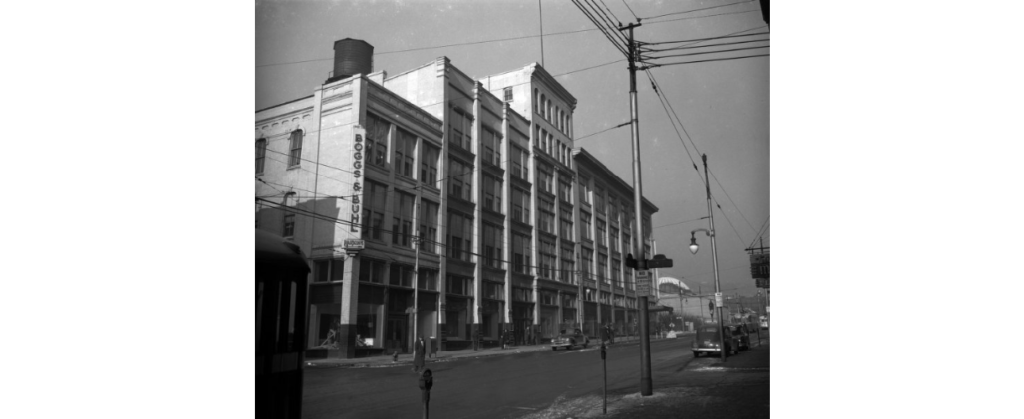
Boggs and Buhls was on the Northside. The photo above shows the Federal Street side of Boggs and Buhl, with the dome of the old Buhl Planetarium visible in the background. Frank and Seders was one of the “downtown” department stores, located at the corner of Smithfield Street and Fifth Avenue. It was also one of the first of the downtown stores to fade into history. My limited memories of Frank and Seders came as the result of my grandmother working there at one point – in the ladies “foundation” department. Grandma, child of Hungarian immigrants, was a portly woman, and I’m sure needed some foundation, and apparently so did a lot of other Pittsburgh women. In those days “foundations” were suits-of-armour looking corsets – pretty scary to a little kid I must admit. Mom would stop in to see Grandma on occasion and we’d all go to lunch in the store cafeteria – yet another feature common to these stores. Rosenbaums, on Penn Avenue, was another of the big downtown department stores. . Mom worked at one point as a waitress in the cafeteria which was on the balcony overlooking the first floor. My brother and I would often meet her on her lunch break and she would buy us a sandwich, and ice cream. As I look back, we often simply took the trolley to town and wandered all over, even as very young boys, something I guess today’s parents wouldn’t dare let their kids do – even if there were still such things as trolley cars. On the Penn Avenue corner was a big clock, mounted on a very ornate post. If we were meeting mom to take the trolley (street car) home together, it would be “Meet me under the clock.” Now that I think back, Gimbels and Kaufman’s also had similar clocks. The left photo below is an early view of the Gimbels building showing the Smithfield Avenue and Sixth Street corner. The right photo below is of the Kaufmann’s clock, perhaps the most ornate of them all. (My father told us years later that he had first met my mother under the Rosenbaum’s clock on their first date.)
Gimbels was yet another department store – located at Smithfield and 6th Avenues. Gimbels, which had stores in New York and other cities too, was sort of the mid-range store. Rosenbaum’s was likely a step down and Joseph Hornes was the premier department store in town. Like most of them, you entered through revolving doors, things that were always exciting to little kids. Sometimes you went round and round several times, unless you were with mom of course. Gimbels also had a set of stairs right on the corner that went down to “Gimbels Basement,” where the bargains supposedly were. What I remember most was that there was also a sub-basement. Once you got in the basement, you could go down more stairs to the sub-basement. Oh what fun places to wander about. When you tired of the basement you started up the escalators to the top floor. Hardly ever bought a thing of course – just had fun.
Joseph Hornes, down near Gateway Center on Penn Avenue, and Kaufman’s, on Smithfield at Fifth (right across from Frank and Seders) rounded out the department stores of downtown Pittsburgh. Seems like we wandered about in Hornes often because it was right across the street from where we caught the number 30 Crafton-Ingram trolley. Kaufman’s was the biggest, they even built an addition that was almost as big as the original store. For whatever reason, their escalators were the most fun too! Except for mom’s Christmas present, which I almost always bought at Kaufman’s, I doubt I actually shopped there often. John Gray, a good friend of my parents, worked for years in the ladies shoe department here – 9th floor I think – so a quick visit to see him was always part of the trip. Kaufman’s had a big book department too, where I did actually buy something once in awhile. Perhaps this – and the Allegheny Carnegie Library – was the place that nutured my love of bookstores – can’t pass one by to this day.
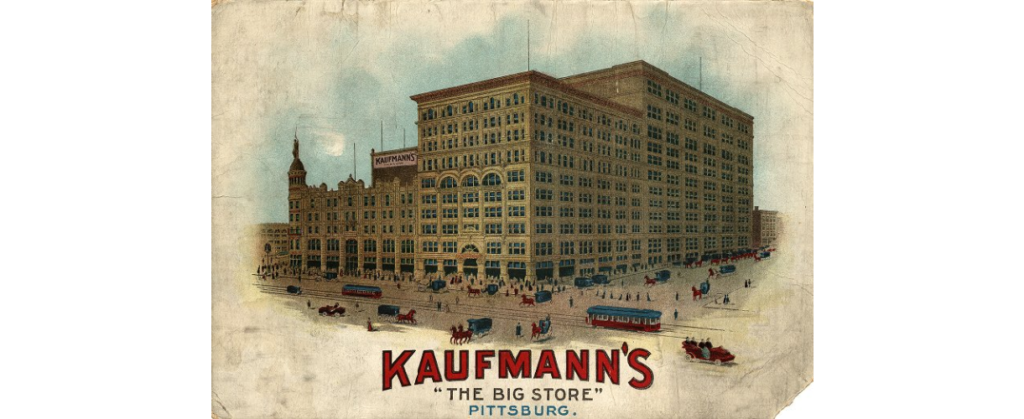
A most special memory of department stores, particularly Hornes and Kaufman’s was the grandly decorated windows at Christmas time. Instead of the normal display of a variety of merchandise, the huge windows that fronted on the main street held wondrous sights and sounds of the holidays, scenes of wintry and holiday fantasy. Families went to town simply to look at the windows. It was an event in its own right. Hornes always turned the Penn Avenue Corner of the building into a Christmas tree, as shown in the photo below.

I mentioned earlier that today one has to go to Walmart or K-Mart to find the likes of a department store. There were stores back then that filled this niche – lower priced and “lower end” merchandise, sort of the Dollar Stores of the times. These were the “5 & 10s,” or the “Five and Dime” stores. W.T. Grant, F.W. Woolworth’s, McCrorey’s, S.S. Kresge’s are a few of the names that come to mind. Usually two floors at least – a big main floor and a “bargain basement” – maybe they got the idea from Gimbels? My most vivid memory of the 5 & 10 was from around Easter time, when there were bins of colored baby chickens, just like little chirping Easter eggs in pink and yellow and blue. They were super cool little playthings, until a few weeks after Easter when they started to turn into teenage chickens – not nearly so cute nor so cuddly. They would soon disappear as Dad “took them to the farm” out the road where he assured us they would grow up to be happy and healthy. It was probably the SPCA or some early form of PETA that stopped the sale of such chicks, but it was fun while it lasted. Another vivid memory of the Five and Dime was the man who always seemed to be near the front entrance demonstrating his super deluxe vegetable chopper-peeler that did everything from dicing your carrots to washing your car. He was better than a circus act.
For most of my young years we did not have a family car, and so the trolley, or the “street car” was our main means of transportation to either downtown, or to change trolleys to go on to Grandma’s house in Homestead, to visit friends out the Library/Drake trolley line, among other places. This was a particularly neat trip because you got to go through the tunnel at the south end of the Smithfield Bridge. The picture at the top of this story shows the number 30 Crafton-Ingram trolley coming across the old Point Bridge. (Please see the other story about Trolley Cars in this section of the website.) Even when we did get a family car (a 1952 Chevy),Dad always needed it for work, and Mom never learned to drive, so the trolley remained vital to our comings and goings.
In addition to the department stores, going down town in my younger days also meant going to “the movies.” This was long before the days of the multi-plex theaters. Each little town – Crafton, Carnegie, Dormont to name but a few, had their own small family-run movie theater. But no matter what the film, going to a movie there was a small-town experience. For the really big shows – Spartacus, Ben-Hur, The Ten Commandments, Cleopatra and the like, you went up Fifth Avenue to the Warner. These were films that were so long there was an intermission. Or maybe that was just another opportunity to sell the popcorn and JuJuBees? The Warner was about as opulent as Pittsburgh got, and it was pretty far up the scale. Fancy carpeting, lots of red velvety-looking stuff, a couple of balconies, chandeliers like the French Kings were used to. Wow! We usually sat in the uppermost balcony – bet they were the cheap seats, but it was an adventure in itself getting up there. The big word in 1950s moviedom was – CINERAMA. The screen was huge, the sound came from all over, you were immersed in the movie experience. Nothing like it existed until the IMAX screens of today came along. But Cinerama films didn’t last. They were just too expensive to make, and only the biggest cities could come up with the kinds of theaters to do them justice.
A few other memories that come to mind are going to the Green Stamp Redemption Center down on Liberty Avenue, and going up to the top of the Gulf Building to the observation deck. Pittsburgh’s skyscrapers were short compared to New York’s I guess, but looking down from the top seemed pretty high up to a kid. The Gulf Building had a pyramid-shaped top that was lit up at night. It would be orange if the weather was fair, but would be blue if rain or snow were in the offing. Being the tallest building in town at the time – until the U.S. Steel building came along years later – the top of the Gulf Building could be seen from all over.
Then there was the Oyster House on Market Square. I mentioned sometimes having lunch with my Grandmother downtown. The Oyster House was one of her favorites, so we sometimes went there. It was basically a bar, long and narrow with a row of small tables down one side. You didn’t wait for a table, you waited for a seat – sharing the table with strangers wasn’t strange there. All the waitstaff were men, with long white aprons. The men standing at the bar at mid-day were always several rows deep, having a “shot and a beer” I suppose. But they had huge and delicious fish sandwiches (as good in my memory as Wholey’s still has today.) They also had what passed for an oyster in Pittsburgh – a fried oyster in enough breading that they were baseball size. I was 22 before I had an oyster on the half shell and had trouble believing THAT really was an oyster! As I mentioned, the place was narrow, so there was no place for a kitchen. It was upstairs, and the food came down on a dumbwaiter. Did Grandma have a shot and a beer with lunch? I really don’t remember.
Opps, I almost forgot. A trip downtown, unless we were shopping or traveling with Mom that is, was not complete without going to visit the indian! I would bet most folks don’t know that there is an indian chief buried in Pittsburgh. Why wouldn’t there be as Pittsburgh started with Fort Pitt, back in the days when indians were part of the picture on what was very much the frontier. Red Pole (indian name MIO-QUA-COO-NA-CAW) lies buried in the churchyard of Trinity Episcopal Cathedral on Sixth Avenue. Red Pole, a Principal Village Chief of the Shawnee Nation, died January 28, 1797. Chief Red Pole was Lamented by the United States. It says so on his tombstone.
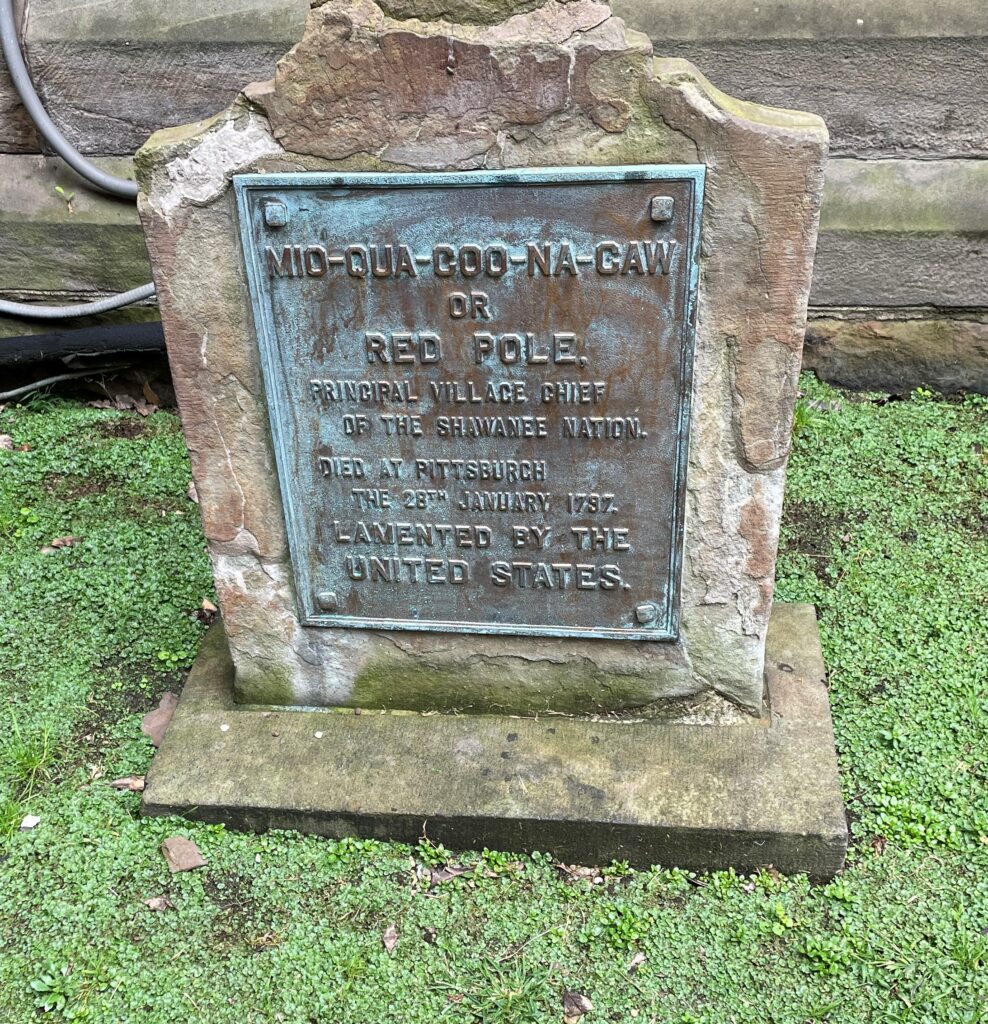
Well there you have it, a few memories from my childhood of “going down town,” to a Pittsburgh that is surely very different today from what it was in the 1950s. I hope this spurs some of yours as well. Someday I’ll tell you about the Army-Navy store down Liberty Avenue, but that too is a tale for another time. The picture below, taken in the 1940s, is actually from a few years before my time, but it’s a neat downtown pic none the less.
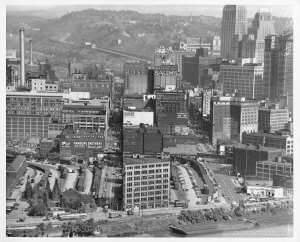

The photo immediately above shows the “Point” area, and much of the downtown “triangle” in the early 1950’s. The Manchester Bridge going to the Northside is in the left foreground. The “Point” bridge, going to Carson Street is in the right foreground. The photo at the top of the page shows a Pittsburgh Railway Company “streetcar” crossing the Point Bridge outbound from downtown.
